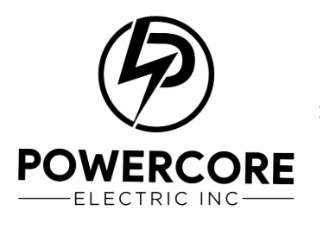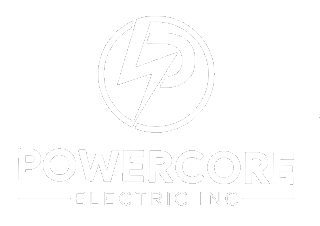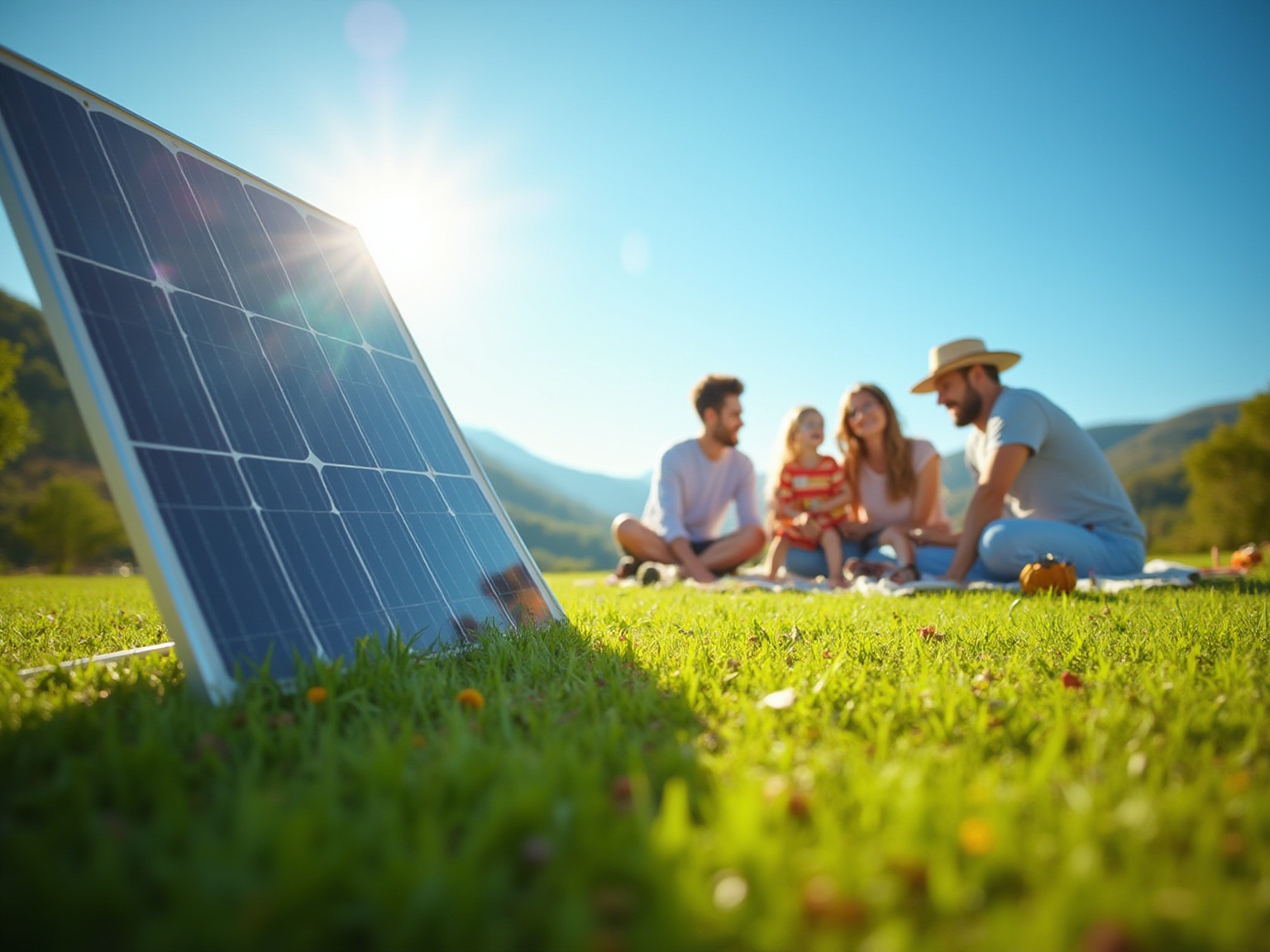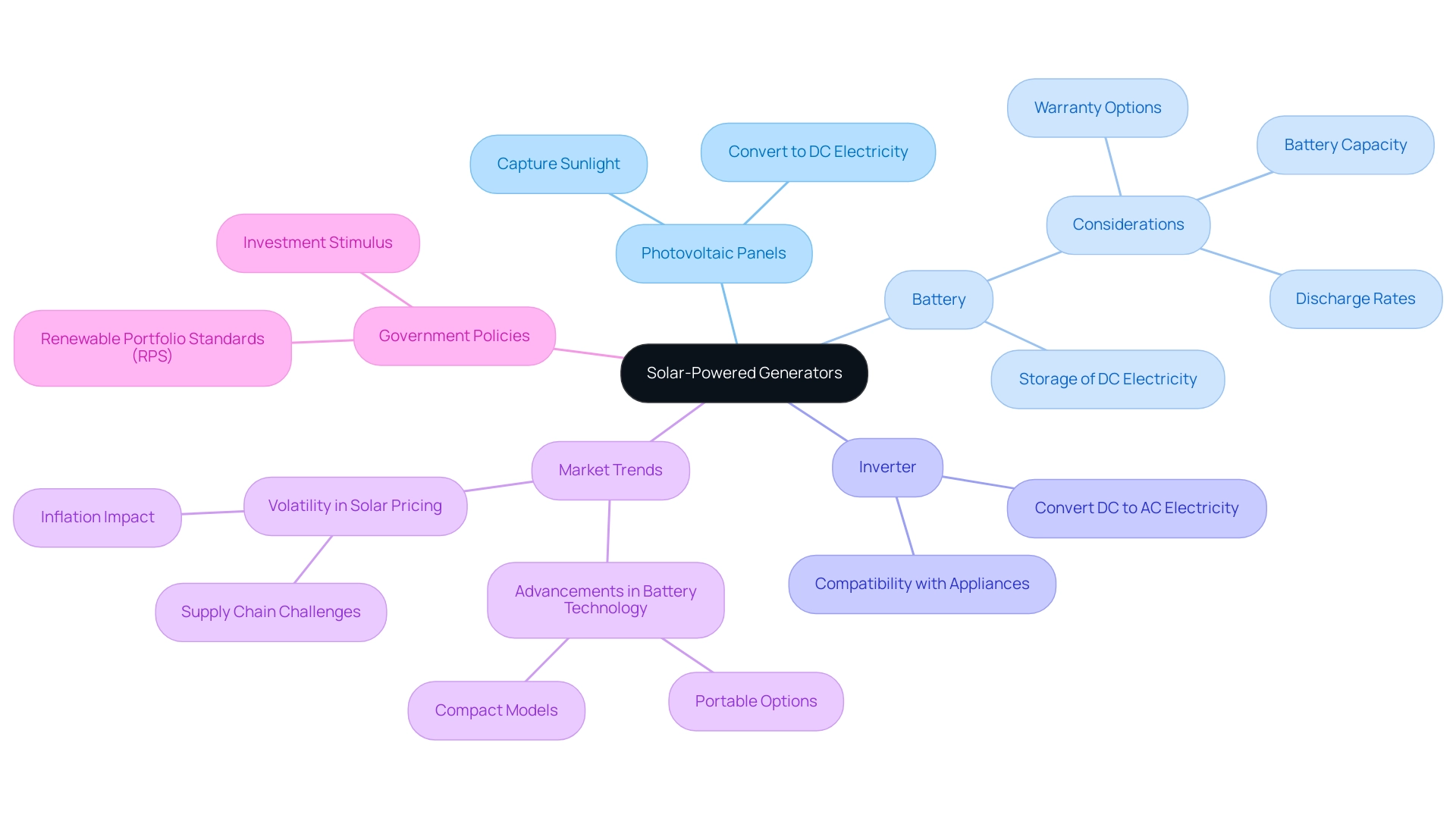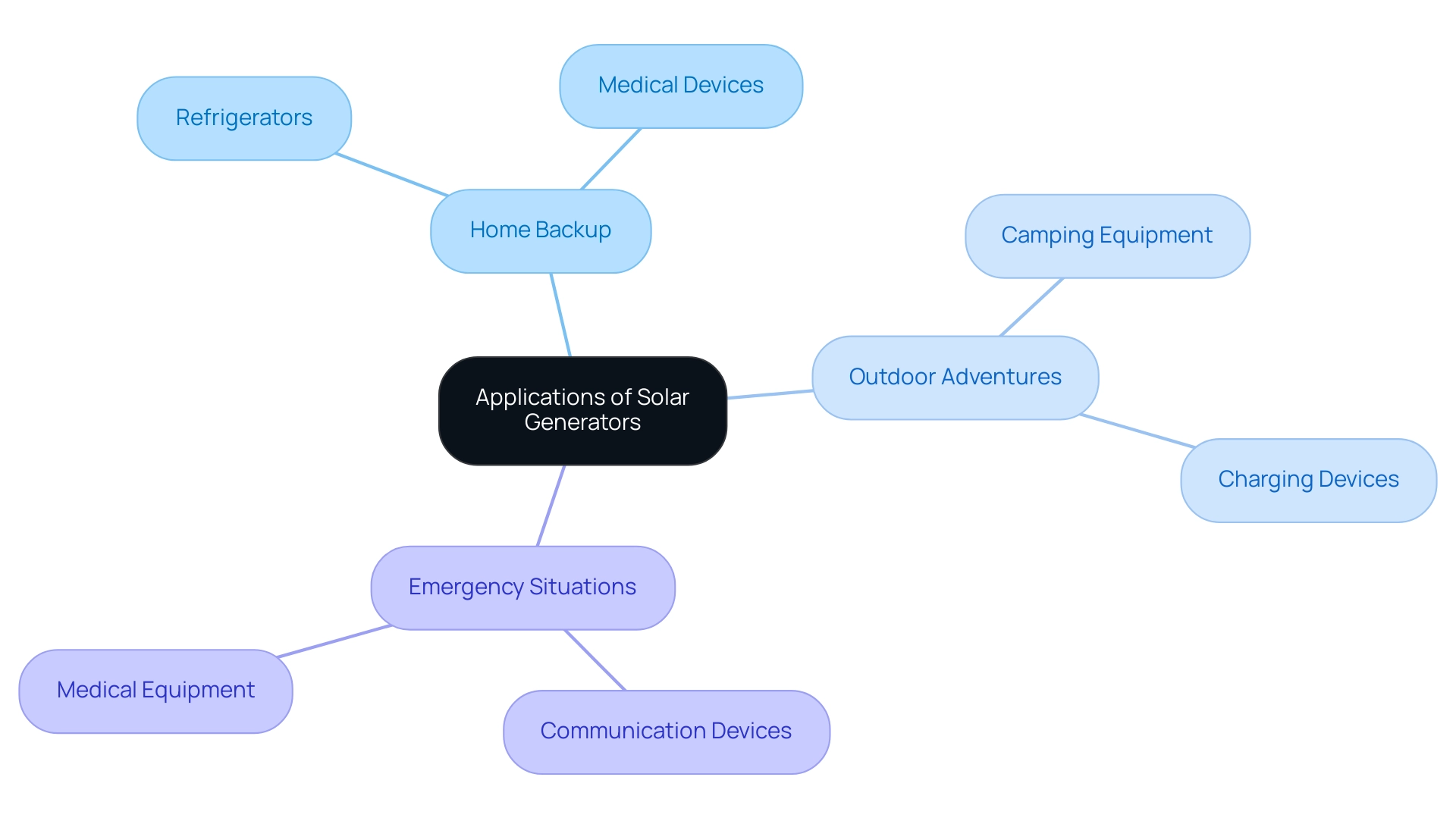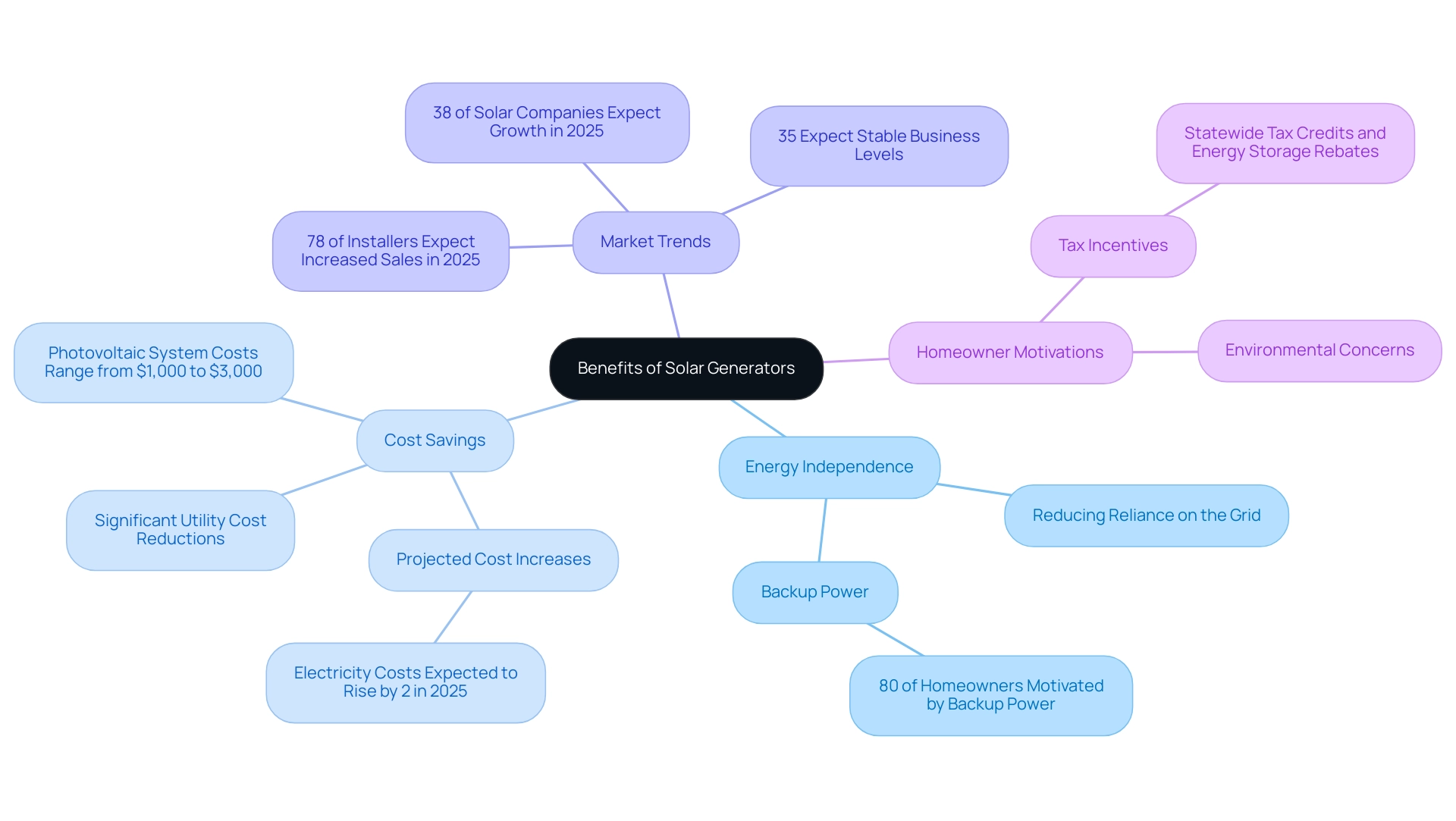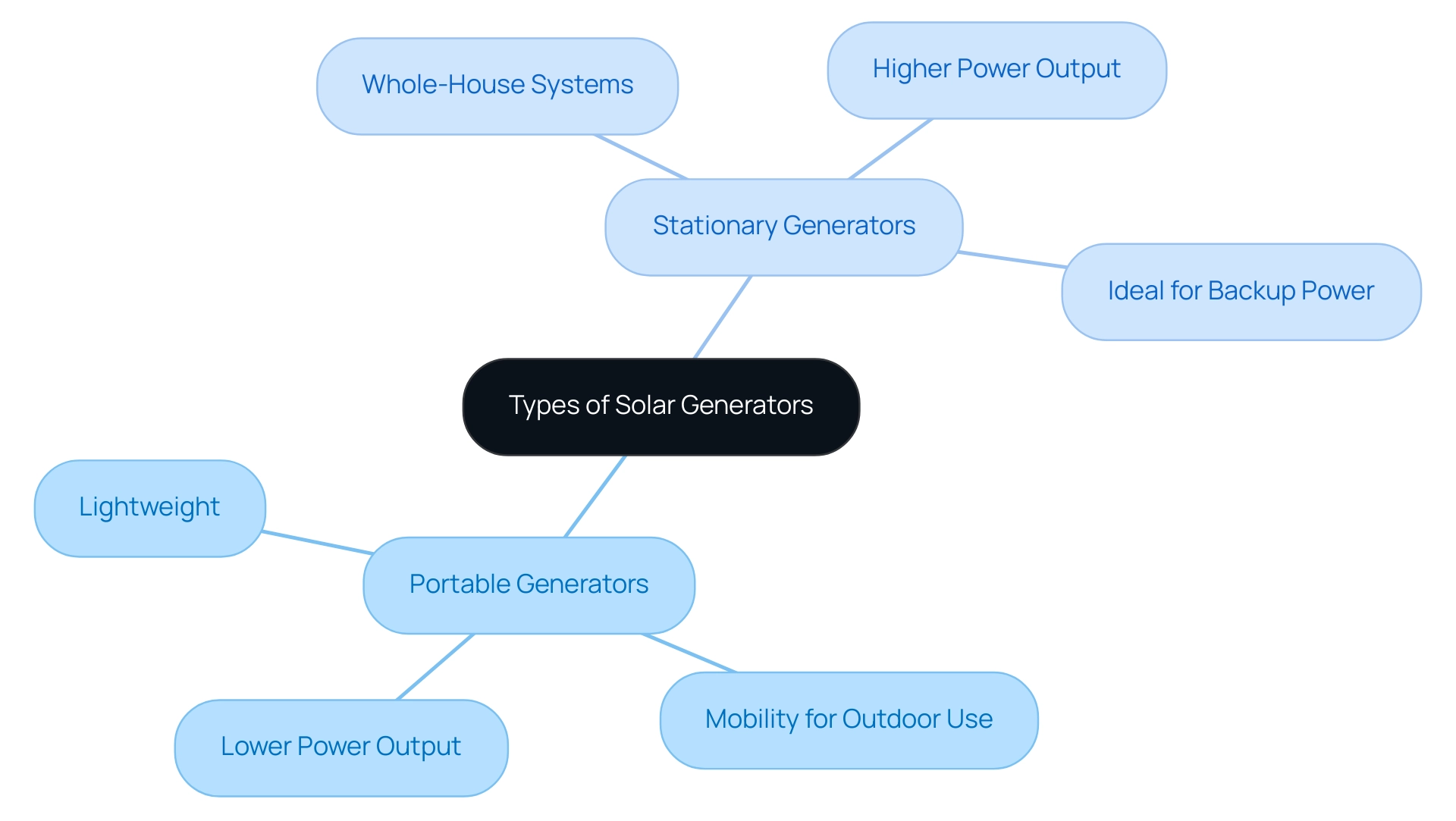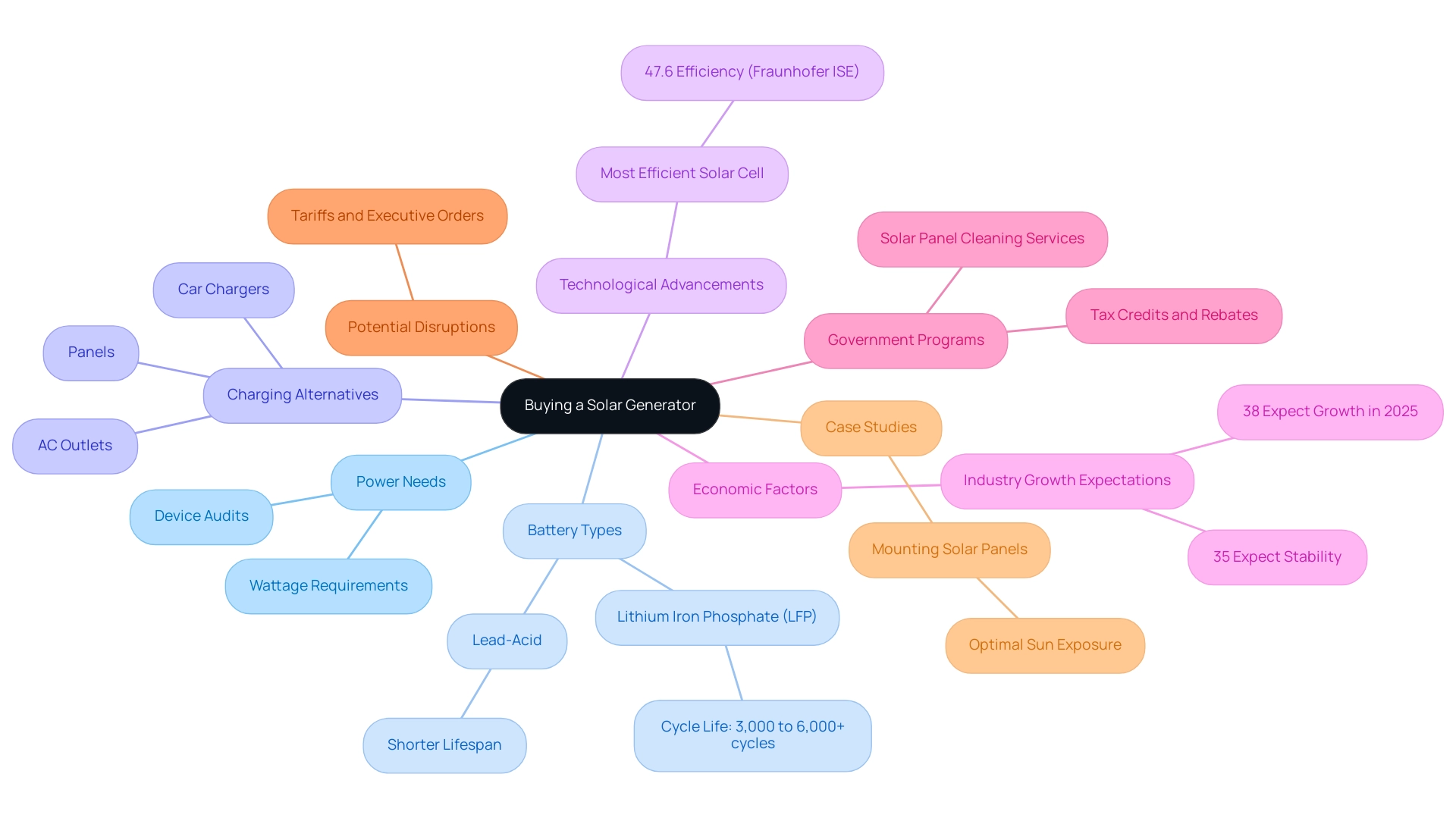Overview
We understand that many homeowners are concerned about rising energy bills and the impact they have on your budget. Solar-powered generators for homes present a compassionate solution, transforming sunlight into usable electricity. This innovative technology not only reduces reliance on traditional power sources but also significantly lowers energy costs, fostering a sense of energy independence.
The key components of these systems—photovoltaic panels, batteries, and inverters—work together seamlessly to harness the sun’s energy. As advancements in technology continue to evolve, more homeowners are discovering the benefits of solar energy. Government incentives further encourage this shift towards sustainable energy solutions, making it easier for families to embrace a greener lifestyle.
Together, we can explore how solar energy can enhance your home and provide lasting savings. Imagine a future where your energy bills are manageable, and you are contributing to a healthier planet. It’s common to feel overwhelmed by the choices available, but rest assured, we are here to guide you through the process. Let’s work towards achieving energy independence and a brighter, more sustainable future for your home.
If you’re ready to take the next step, please reach out to us. We are dedicated to supporting you on this journey and ensuring you feel confident in your decision.
Introduction
In a world increasingly focused on sustainability, we understand that many homeowners are concerned about rising energy bills and the impact of traditional power sources on the environment. Solar-powered generators are emerging as a game-changer for those who are eco-conscious and seek a more sustainable lifestyle. These innovative systems transform sunlight into usable electricity, providing a reliable energy source that not only reduces dependence on traditional power grids but also cuts down on energy costs.
With advancements in technology leading to more compact and efficient models, the appeal of solar generators extends beyond mere backup power; they are becoming integral to everyday energy needs. It’s common to feel overwhelmed by the options available, but as the market continues to evolve, understanding the various types of solar generators and their applications is essential for homeowners looking to harness the power of the sun and achieve energy independence.
Together, we can explore how these solutions can fit into your life and help you take control of your energy future.
What Are Solar-Powered Generators and How Do They Work?
Are you feeling overwhelmed by rising energy bills? Solar-powered generators for homes offer a groundbreaking solution for eco-conscious residents like you, adeptly converting sunlight into usable electricity. These systems consist of three vital elements:
- Photovoltaic panels
- A battery
- An inverter
Solar panels capture sunlight and convert it into direct current (DC) electricity, which is then stored in a battery for later use. The inverter plays a crucial role, converting the stored DC electricity into alternating current (AC) electricity, which is compatible with most household appliances.
This efficient process empowers homeowners to leverage renewable energy, significantly reducing dependence on traditional power sources and lowering energy costs. Recent advancements in photovoltaic power technology have introduced more compact and portable models, with some weighing as little as 10 pounds, enhancing accessibility for residential use.
As of 2025, the generator market has experienced remarkable improvements in functionality, driven by advanced battery technology and refined manufacturing processes. Government policies such as Renewable Portfolio Standards (RPS) have stimulated investment in photovoltaic energy, encouraging homeowners to adopt these sustainable practices. Such initiatives are vital, as they help buffer against the recent caused by inflation and supply chain challenges.
Experts emphasize the effectiveness of modern energy converters. Ben Zientara, a renewable energy policy analyst, asserts that “the sheer amount of power output and input makes the AC300 + B300 combo the very best choice for off-grid cabins, tiny houses, RVs, remote worksites, and even live music events.” This trend emphasizes the increasing tendency of property owners towards solar-powered generators for homes, not only as backup power sources but for daily power requirements.
When choosing the best batteries for effective energy storage, property owners should consider aspects such as battery capacity, discharge rates, and warranty options. Leading products in the market, like lithium-ion and lead-acid batteries, each offer unique advantages in terms of longevity and cost-effectiveness. For more detailed guidance, property owners can refer to user manuals that explain how to select the best batteries for energy systems and understand panel functionality.
With over 30 years of experience serving the California community, Powercore Electric is here to assist you in navigating these innovative technologies. As sunlight technology continues to advance, solar-powered generators for homes are set to become a reliable and effective choice for residential energy solutions, showcasing their potential to transform how we power our homes sustainably. Together, we can work towards a brighter, more sustainable future.
Applications of Solar Generators: From Home Backup to Outdoor Adventures
Solar power devices are remarkably versatile, serving a multitude of purposes that cater to both home and outdoor needs. We understand that energy bills can be a significant concern for many homeowners. For home backup, solar-powered generators provide a dependable source of power during outages, ensuring that essential appliances, such as refrigerators and medical devices, remain operational. In fact, statistics indicate that nearly 70% of homeowners regard renewable energy devices as a critical element of their emergency preparedness plans in 2025.
Beyond home use, portable power sources are becoming increasingly popular for outdoor activities, including camping and tailgating. They can efficiently power lights, cooking equipment, and charge electronic devices, making them indispensable for modern outdoor experiences. It’s common to feel overwhelmed by the choices available, but real-life instances from 2025 demonstrate that campers are using renewable energy sources not only for convenience but also to reduce their environmental impact, aligning with the increasing trend of eco-conscious outdoor activities.
In emergency situations, photovoltaic systems can be lifesavers, supplying power for communication devices and medical equipment when conventional energy sources are unavailable. Their portability enhances their appeal, allowing users to easily transport them for both home use and outdoor excursions.
Furthermore, specialist views emphasize the significance of renewable power sources in improving autonomy. Jane Curtis, CEO of Renon Power, observes that ‘UL certified batteries generally include comprehensive installation guidelines, encompassing the required tools and procedures,’ which highlights the practicality of utilizing photovoltaic systems. As the need for dependable and sustainable power solutions continues to grow, especially considering recent challenges in the photovoltaic system market due to supply chain disruptions, solar-powered generators for homes are positioned as a key player in the power landscape.
Moreover, , including tax credits and storage rebates, enhance the attractiveness of photovoltaic systems, rendering them a financially viable investment for property owners. Powercore Electric, with over 30 years of experience serving California communities, is committed to personalized service and community focus. Their dedication to client contentment guarantees that customers obtain the assistance they require to shift to solar-powered generators for homes, highlighting the importance of renewable power systems for both homeowners and outdoor enthusiasts alike.
“Ryan and his team were great. ‘They were fast, efficient, and stayed on schedule for our energy installation,’ shares a satisfied customer. This level of satisfaction reflects Powercore Electric’s commitment to exceptional service.
For Long Beach tenants, it’s crucial to evaluate local government initiatives that can help in the shift to renewable power. Investigating available incentives and comprehending the installation process can greatly simplify the path toward embracing renewable energy solutions. Together, we can work towards a sustainable future that not only benefits our homes but also our planet.
The Benefits of Solar Generators: Energy Independence and Cost Savings
Are you feeling overwhelmed by rising energy bills? You’re not alone. Many homeowners, especially in sunny regions like Southern California, are seeking ways to gain more control over their energy costs. Solar powered generators for homes offer a compelling solution, allowing you to reduce your reliance on the grid. This independence is particularly beneficial during power outages or in remote areas, enhancing your resilience and leading to significant cost savings over time.
Imagine a power solution that not only eliminates ongoing fuel costs but also requires minimal upkeep. Solar powered generators for homes provide just that, presenting a sustainable way to lower your electricity expenses.
As we look ahead to 2025, many property owners are recognizing the financial benefits of photovoltaic systems. A notable percentage are taking advantage of tax incentives, including statewide tax credits and storage rebates, making renewable energy a smart choice for those who care about the environment. A recent study even found that 80% of homeowners who adopted solar powered generators did so for backup power, highlighting the growing importance of energy resilience over purely financial motivations.
When considering costs, photovoltaic systems typically range from $1,000 to $3,000, depending on their capacity and features. Traditional electricity costs, on the other hand, are projected to in 2025. This makes solar powered generators not only a cost-effective option but also a safeguard against future electricity price increases. Furthermore, industry insights reveal that 78% of installers expect an increase in sales this year, underscoring the growing interest in these systems.
Ben Zientara, a writer and renewable energy policy analyst, shares that 38% of companies in this sector anticipate growth in 2025, with another 35% expecting stable business levels. This trend reflects a broader recognition of the financial advantages associated with photovoltaic power systems.
Practical examples abound, with many residents reporting significant reductions in their utility costs after switching to photovoltaic units. As our energy consumption landscape evolves, solar powered generators for homes are increasingly vital in promoting both financial savings and energy independence. This is especially true for renters in Long Beach who are seeking eco-friendly energy solutions.
Together, we can explore how solar energy can transform your energy experience, providing not just savings but also peace of mind. Let’s work towards a sustainable future that benefits both you and the environment.
Types of Solar Generators: Choosing the Right One for Your Needs
We understand that many homeowners in Long Beach are concerned about rising energy bills and the impact of their choices on the environment. The market offers a varied selection of energy systems tailored to meet these specific needs, making them an excellent choice for those who prioritize sustainability. Portable power units, lightweight and designed for mobility, are perfect for camping trips or outdoor activities. On the other hand, larger stationary models of solar-powered generators for homes provide reliable backup power during outages, ensuring peace of mind when you need it most.
Whole-house power systems stand out for their ability to support multiple devices simultaneously, which is especially beneficial for residents seeking comprehensive power solutions. In 2025, the residential sector continues to lead the power device market, driven by an increasing demand for sustainable energy options that cater to home appliances and charging stations. Many homeowners are now opting for solar-powered generators to achieve energy autonomy and reduce reliance on traditional electricity providers. A significant trend is the growing preference for stationary renewable energy systems, which offer higher power outputs and battery capacities compared to their portable counterparts.
Additionally, companies like Jackery have responded to evolving consumer needs by expanding their offerings, including the introduction of the 3000 Pro and 1500 Pro models in January 2023. Findings from the case study ” reveal that the residential sector is indeed the largest market for solar-powered generators, as homeowners increasingly seek sustainable solutions for their energy needs. This trend is supported by regional studies across North America, Europe, Asia-Pacific, South America, and the Middle East and Africa, highlighting the global shift towards renewable energy.
When considering a renewable energy source, it’s essential to evaluate various factors such as energy output, battery capacity, and portability. Understanding government programs that incentivize the adoption of solar-powered generators can enhance the overall value of your investment. For instance, if your primary concern is to power essential appliances during outages, a whole-house system with robust battery capacity would be ideal. Conversely, if you need a power source for occasional outdoor use, a portable model may suffice.
As the market evolves, it’s crucial to grasp the distinctions between portable and stationary energy systems. Portable models typically have lower power outputs and are designed for convenience, while stationary models are built for higher capacity and longer usage times. By assessing your personal power requirements and lifestyle choices, you can make informed decisions about the right renewable power source for your needs, ensuring you embrace eco-friendly solutions effectively.
Furthermore, comparing solar power sources with gas-powered options reveals significant benefits in efficiency and environmental impact. While gas generators may provide immediate power solutions, solar-powered generators offer a sustainable and cost-effective long-term energy source. It’s important to recognize that photovoltaic panels can still generate electricity on cloudy days, albeit at a reduced output. This consideration is vital when evaluating the reliability of energy solutions, especially for those living in areas with unpredictable weather patterns.
Key Considerations When Buying a Solar Generator for Your Home
When choosing a solar power system, we understand that eco-conscious homeowners are often concerned about rising energy bills and the impact on their budgets. It’s essential to thoroughly assess several crucial factors to ensure a well-informed choice. Start by evaluating your power needs: calculate the wattage of the devices you intend to run. For instance, the average wattage requirements for common household appliances can vary significantly, with essential devices like refrigerators typically requiring around 100-800 watts, while larger appliances may demand even more.
Battery capacity is another vital consideration, as it directly influences how long your generator can provide power. Lithium Iron Phosphate (LFP) batteries, for example, feature an impressive , making them a durable option for long-term power storage. While lead-acid batteries are less expensive, they typically have a shorter lifespan and fewer cycles.
Understanding the key specifications and types of batteries available, including their economic benefits, can lead to greater energy independence and peace of mind.
Charging alternatives also play an essential role in the functionality of your renewable power source. Many models provide adaptable charging options, including panels, AC outlets, and car chargers, allowing flexibility based on your circumstances. If you already have a photovoltaic system set up, ensuring compatibility with your current arrangement can significantly enhance the device’s efficiency and overall performance.
As we look towards 2025, key considerations when acquiring a generator include understanding the latest advancements in technology for harnessing sunlight. For instance, the record for the most efficient photovoltaic cell, achieved by Fraunhofer ISE, stands at an impressive 47.6% efficiency, highlighting the potential for improved energy generation. Furthermore, according to Ben Zientara, a writer and energy policy analyst, “38% of all companies in the sector expect to grow in 2025, and an additional 35% think they will maintain the same level of business,” indicating a positive outlook for the industry despite current challenges.
It’s also vital to be aware of possible disruptions in the renewable energy sector, such as tariffs and executive orders influencing funding, which could affect your investment in renewable power systems. Comprehensive insights into government programs, such as tax credits and rebates for solar installations, along with available solar panel cleaning services, can further enhance your solar power experience.
Expert recommendations indicate that property owners should also consider the device’s portability and ease of use, particularly if they intend to utilize it for outdoor activities or during emergencies. Real-world examples illustrate how homeowners have successfully assessed their power needs by conducting audits, which help identify the most critical devices to power during outages. Furthermore, installing photovoltaic panels entails linking them to the power source and verifying they are arranged for optimal sunlight exposure, which is essential for maximizing efficiency.
By taking these factors into account, including the specific types of batteries and their economic benefits, as well as understanding how solar panels work, you can select a solar generator that aligns with your energy requirements and lifestyle. Together, we can ensure a reliable and sustainable power source for your home, paving the way for a brighter, more eco-friendly future.
Conclusion
We understand that rising energy bills can be a significant concern for homeowners. Solar-powered generators are here to transform your energy consumption, offering a sustainable and cost-effective alternative to traditional power sources. These innovative systems convert sunlight into usable electricity, which can significantly reduce your energy costs and reliance on the grid. With the latest advancements in technology, solar generators are now more efficient and portable, making them essential for everyday use and emergency preparedness.
Imagine the peace of mind knowing that you can power essential home appliances during outages or enhance your outdoor adventures like camping. As the demand for renewable energy solutions rises, investing in solar generators becomes a practical choice, further incentivized by financial benefits available to homeowners.
Choosing the right solar generator may seem daunting, but it involves simply evaluating your energy needs and battery capacities, as well as understanding the differences between portable and stationary models. By making informed decisions, you can effectively harness solar technology to boost your energy independence and minimize your environmental impact.
In summary, solar-powered generators represent a vital step toward a sustainable energy future. By utilizing solar power, you can achieve long-term savings while contributing to a healthier planet. Together, let’s work towards ensuring a reliable and eco-friendly energy source for years to come. Investing in solar generators is not just a choice; it’s a proactive approach to securing a brighter future for you and the environment.
